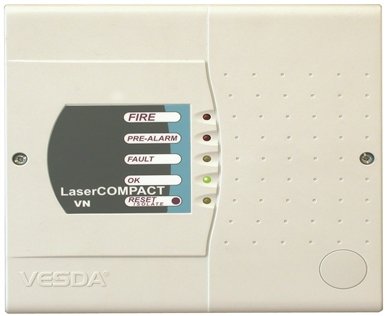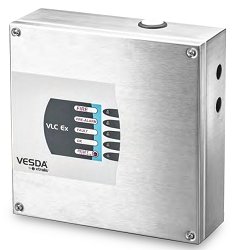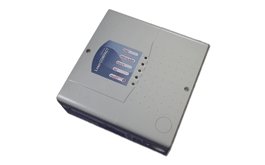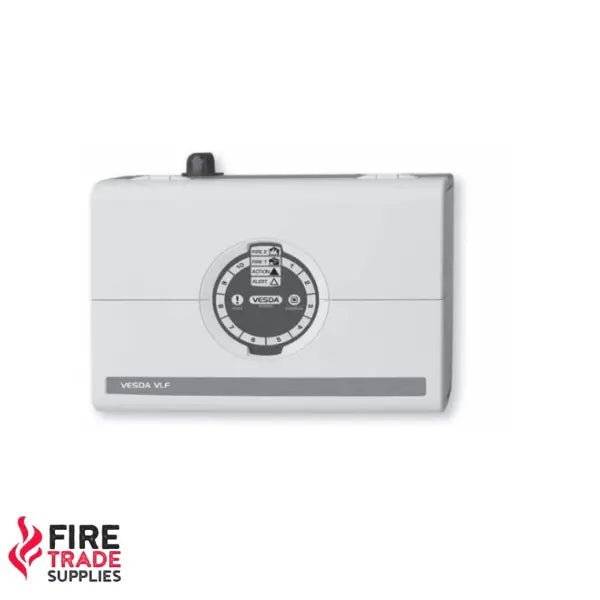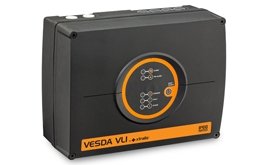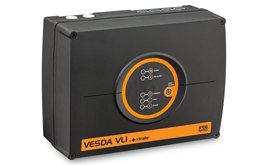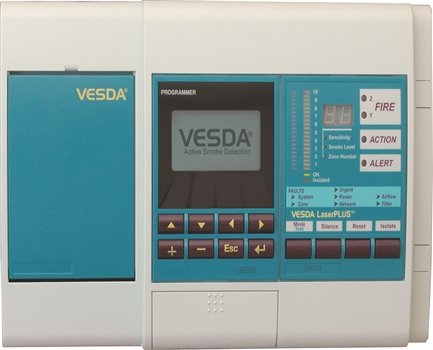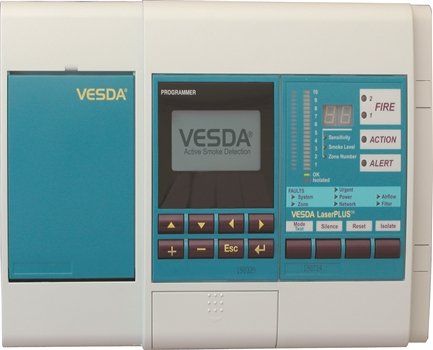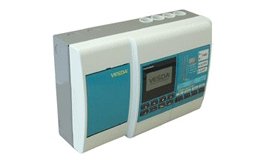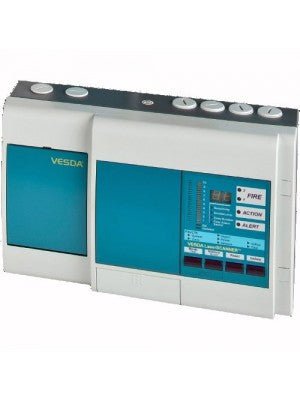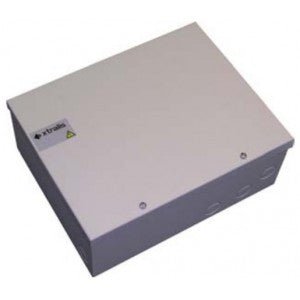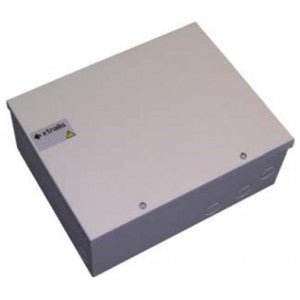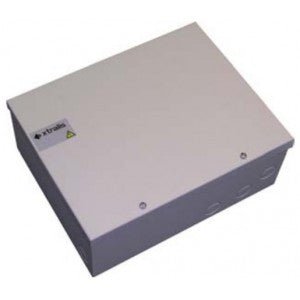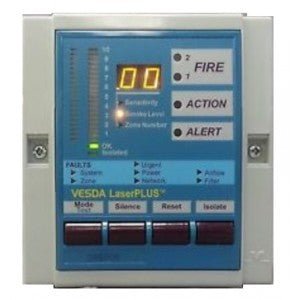
Vesda
VESDA Fire Systems
As pioneers in the realm of life safety, VESDA fire suppression systems (Honeywell) lead the global stage with their specialty in Very Early Warning Aspirating Smoke Detection (VESDA) systems.
With the ever-looming threats of fire hazards, VESDA systems offer a shield of security like no other — reliably detecting even the faintest whispers of smoke in the air.
What Is a VESDA Fire System and How Does It Work?
VESDA stands for Very Early Smoke Detection Apparatus. Utilising aspirating smoke detection technology, VESDA systems actively sample air through a network of pipes, detecting smoke particles at the earliest conceivable stage — often before visible smoke or a traditional fire alarm trigger.
A typical VESDA system includes:
- A central detection unit (e.g., VLF, VEP, VLI models)
- A network of sampling pipes strategically placed across the protected area
- A fan module drawing air continuously through the pipes
- A high-sensitivity laser detection chamber
This proactive approach provides time-critical alerts, giving building managers a head start in incident response and reducing the risk of unnecessary business disruption or evacuation.
Learn more about our VESDA systems.
What is the difference between a VESDA panel and a smoke detector?
VESDA fire detection systems are globally recognised for their unparalleled sensitivity and reliability. Here’s why professionals choose VESDA:
- Multiple alarm thresholds: Alert, Action, Fire 1, and Fire 2 for graduated responses
- High sensitivity: Detect smoke at concentrations invisible to the human eye
- False alarm reduction: Advanced filtration and sampling intelligence
- Flexible deployment: Ideal for clean rooms, museums, warehouses, and historic sites
- Reliable in harsh conditions: Units like the VLI are designed for dusty, dirty, and industrial environments
- Remote diagnostics: Many models feature real-time status updates, air quality tracking, and self-cleaning options
View our VESDA detectors for tailored solutions across industries.
Where Are VESDA Systems Used?
VESDA fire protection systems are essential in environments where early detection can mean the difference between safety and disaster:
- Data centres & server rooms — prevent downtime, protect digital assets
- Industrial manufacturing facilities — where smoke detection must overcome dust and airflow challenges
- Hospitals and medical labs — strict cleanliness requirements and false-alarm avoidance
- Cold storage & logistics hubs — low temperatures or high humidity can disrupt traditional detectors
- Museums, galleries, and historic archives — safeguarding priceless assets from smoke damage
- Transport hubs, luxury residential projects, and power stations — where downtime or damage poses critical risk
Protect your critical infrastructure with VESDA fire systems from Fire Trade Supplies.
Certifications & Compliance for VESDA Aspirating Smoke Detection
VESDA (by Honeywell/Xtralis) aspirating smoke detectors (ASDs) are independently tested and certified to key life-safety standards used in the UK and worldwide. Specific approvals vary by model, but typically include:
-
EN 54-20 (Classes A, B, C) — European product standard for ASDs.
- Class A: Very high sensitivity (early warning in critical spaces such as data centres/clean rooms)
- Class B: Enhanced sensitivity (atriums, high-value areas)
- Class C: Normal sensitivity (general spaces/warehousing)
- Third-party approvals (model-dependent): LPCB, VdS, UL/ULC, FM, ActivFire and others recognised by insurers and authorities.
- CE (CPR) and/or UKCA marking — as applicable for the product family and market.
-
Associated equipment standards may also apply, for example:
- EN 54-4 (power supplies)
- EN 54-17 (short-circuit isolators)
- EN 54-13 (system compatibility/integration), where stated by the manufacturer
Documentation: Declaration of Performance (DoP), certificates and test reports are available per model. Check the product datasheet on each item page or contact our team and we’ll supply the exact certificates required by your AHJ/insurer.
Note: Always verify the exact model’s approvals and classification before specification or installation. Sensitivity class, pipe network design and sampling hole spacing must be engineered to suit the risk and environment.
At Fire Trade Supplies, all our VESDA panels are supplied with the relevant documentation and meet the applicable standards.
Recently viewed
Vesda FAQ's
A VESDA system constantly samples the air through a network of pipes and analyses it for the smallest traces of smoke, providing advanced warning long before conventional detectors activate.
Traditional smoke detectors respond once smoke has already reached the sensor. VESDA, however, actively draws in air and analyses it, making it far more sensitive and capable of giving earlier alerts.
VESDA systems are designed with maintenance in mind. While they do require periodic filter changes and system checks, servicing is straightforward for trained engineers.
The initial investment is higher than standard detectors, but the early warning benefits, reliability, and reduced downtime often make VESDA more cost-effective in high-value or mission-critical environments.
VESDA detectors integrate with conventional or addressable fire alarm panels via relay outputs or direct communications modules, allowing alarms and fault signals to be reported instantly.
Typically, filters last 2–4 years, depending on the environment. In dustier conditions, they may need replacing sooner to keep the system working effectively.
Test points are positioned on the sampling pipe network, usually at accessible locations, to allow engineers to introduce smoke or test gas during routine maintenance.
VESDA systems use multiple alarm stages, often including:
Alert – very early smoke detection
Action – smoke levels increasing, investigation required
Fire 1 – significant smoke detected
Fire 2 – high concentration, immediate response needed
VESDA is typically required in high-risk or sensitive environments such as data centres, cleanrooms, cold storage, airports, and heritage buildings where early detection is vital.
Still Have Questions?
If we still haven't answered your question, you can contact us below and we will get back to you as soon as possible.

